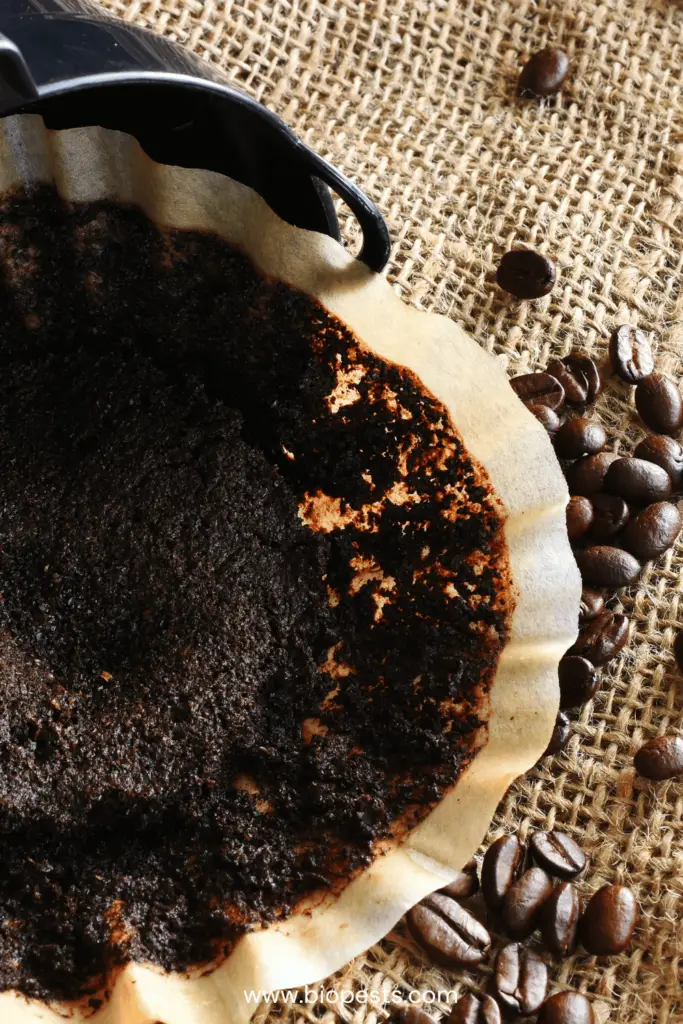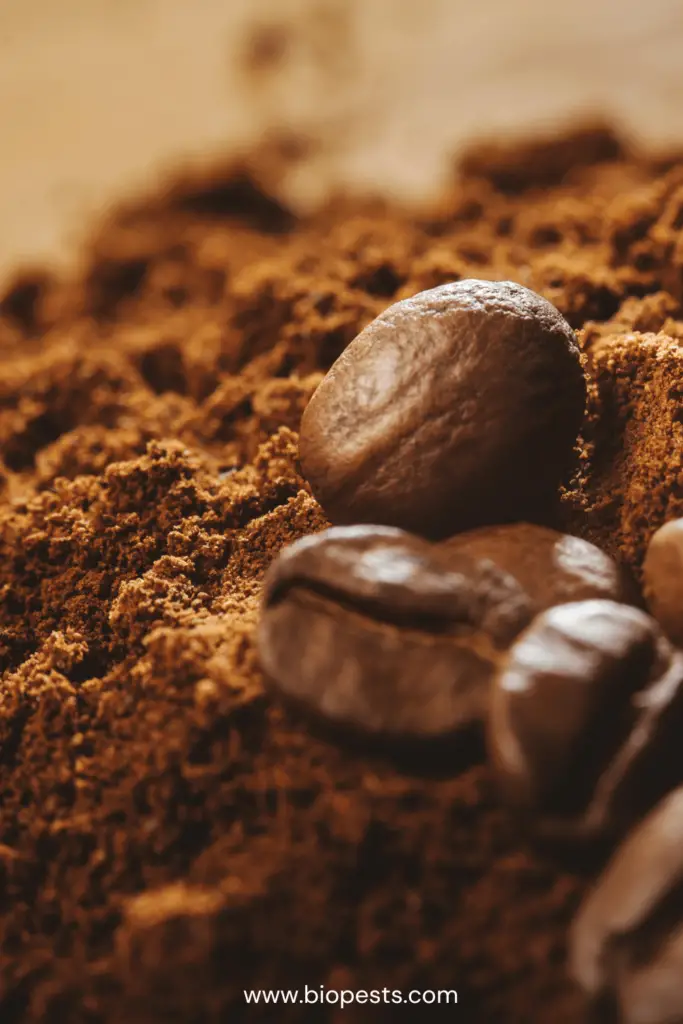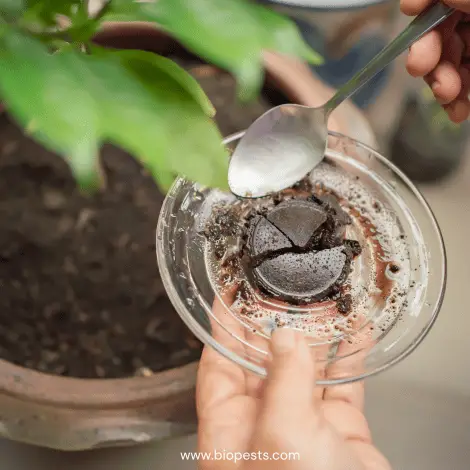Are you noticing mold on your coffee grounds? While using coffee grounds in gardening offers plenty of benefits, mold growth is a common concern. Let’s uncover why this happens and how to prevent it for a healthier garden.
Benefits of Using Coffee Grounds in Gardening
Coffee grounds are a popular choice for gardeners. They enrich the soil with organic matter and essential nutrients like nitrogen, potassium, and magnesium. Additionally, coffee grounds can improve soil structure, helping with drainage and water retention.
If you want to know more about coffee as a planting medium, read my article here.
Furthermore, using coffee grounds is an eco-friendly practice that supports sustainable gardening. It reduces waste and offers a natural way to enhance soil fertility.
Despite these benefits, many gardeners face mold issues when using coffee grounds.
Understanding Mold on Soil
Mold is a type of fungus that thrives in moist, warm environments. On soil, mold appears as a fuzzy, white, or grayish layer. Mold growth occurs when there is an imbalance in soil conditions, such as excess moisture or poor air circulation.
While mold may seem alarming, it’s not always harmful to plants. However, mold can indicate issues with soil health that need to be addressed. Moldy soil can lead to root rot and other plant diseases if left untreated.

Causes of Mold Growth in Soil
Several factors contribute to mold growth in soil. These include:
- Excess Moisture: One of the most common causes of mold on soil is overwatering. When soil remains waterlogged, it creates an ideal environment for mold to thrive. Additionally, poor drainage can exacerbate the problem, as water accumulates at the roots, encouraging fungal growth. If you are experiencing problems with your soil not drying, please read here.
- Poor Air Circulation: Compact soil or overcrowded plants reduce airflow, promoting fungal growth. Good air circulation and adequate light are crucial for preventing mold. Stagnant air and shaded areas can trap moisture, making it easier for mold to develop. Ensuring that your plants have proper ventilation and receive enough sunlight can go a long way in keeping mold at bay.
- Organic Matter: While organic matter like compost or coffee grounds is beneficial for soil health, its decomposition can sometimes lead to mold growth. The breakdown of organic materials produces moisture and heat, which can create a breeding ground for mold. It’s essential to balance organic matter with other soil components to avoid this issue.
Understanding these causes helps in preventing mold and maintaining healthy soil.
Why Coffee Grounds Attract Mold
The relationship between coffee grounds and mold is complex. Coffee grounds provide organic material that, when decomposed, benefits the soil. However, they can also retain moisture, creating conditions conducive to mold growth.
Coffee grounds are rich in nitrogen, which is beneficial for soil but can also attract mold. When coffee grounds are left on the soil surface, they can trap moisture, creating a perfect environment for mold spores to thrive.
Impact on Plant Health
While mold on coffee grounds is common, it’s not always harmful. However, excessive mold can compete with plants for nutrients and may indicate underlying soil health issues. Monitoring mold growth and addressing its causes is crucial for healthy plants.
6 Effective Tips for Mold Prevention on Coffee Grounds
Preventing mold growth involves several practical steps. By managing moisture and improving soil conditions, gardeners can enjoy the benefits of coffee grounds without the mold.
1. Mix Coffee Grounds into Soil:
Rather than leaving coffee grounds on the surface, mix them into the top layer of soil. This helps distribute moisture more evenly and reduces the chance of mold growth.
2. Ensure Proper Drainage:
Use well-draining soil and containers with drainage holes to prevent water from accumulating. Avoid overwatering by checking soil moisture before watering your plants.
3. Improve Air Circulation:
Space plants appropriately to ensure good airflow. Regularly loosen the soil to prevent compaction, which can restrict air movement.
4. Composting:
Compost coffee grounds with other organic materials before adding them to your garden. This process breaks down the grounds and reduces the risk of mold.
5. Using Dry Grounds:
Allow coffee grounds to dry out before using them in the garden. This reduces their moisture content and the likelihood of mold growth.
6. Balanced Soil Amendments:
Combine coffee grounds with other soil amendments, such as leaf mold or compost, to balance nutrient levels and improve soil health.

3 Easy Steps to Fix Moldy Soil
Now that you’ve identified the problem and its causes, it’s time to take action. Here are some tried-and-true methods to restore your soil’s health using organic and sustainable practices.
Removing Affected Soil
Start by carefully removing the top layer of moldy soil/coffee grounds. Dispose of this soil away from your plants to prevent spores from spreading.
Introducing Beneficial Microbes
Incorporate compost or well-decomposed organic matter into the soil. This introduces beneficial microbes that compete with mold and improve soil health.
Adjusting Watering Practices
Ensure you’re not overwatering. Water your plants only when the top inch of soil feels dry. Properly timed watering can make a significant difference.
Mold as an Indicator of Soil Health
Interestingly, mold growth can serve as an indicator of soil health. While the presence of mold might seem alarming, it often signifies that the soil has a rich organic content. Saprophytic fungi, which include many types of mold, play a vital role in breaking down organic matter and returning nutrients to the soil.
However, if mold appears excessive, it may indicate an imbalance in soil conditions, such as poor drainage or overapplication of organic matter. Monitoring mold growth and testing the soil can provide valuable insights into your soil’s health and guide you in making necessary adjustments to improve its condition.
Interpreting Mold Growth
- Nutrient Imbalance:
- Mold may indicate an excess or deficiency of certain nutrients. Testing soil and adjusting fertilization practices can address these imbalances.
- Moisture Levels:
- Consistent mold growth suggests issues with soil moisture. Adjust watering practices and improve drainage to maintain optimal moisture levels.
Conclusion
Moldy coffee grounds on your plants can be a sign of underlying soil issues. By understanding the causes of mold growth and taking preventive measures, you can maintain healthy soil and enjoy the benefits of coffee grounds in your garden.
Remember, sustainable gardening is about balance and care. Take the time to understand your soil, and your plants will thank you.
For more tips and expert advice, don’t hesitate to reach out to our community of gardeners. Happy gardening!
Some of the links above are affiliate links, meaning, at no additional cost to you, I will earn a commission if you click through and make a purchase.
Articles you might be interested in:

